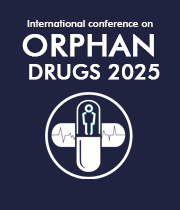Title : Orphan and rare disease emerging as a global public health priority through the view of personalized and precision medicine: How to use the latter to revolutionize pediatric services
Abstract:
A new systems approach to subclinical, predictive and/or diseased states and wellness resulted in a new Hi Tech trend in the healthcare services, namely, Personalized and Precision Medicine (PPM). Meanwhile, despite breakthroughs in designed-driven research that have led to an increased understanding of PPM-based disease, the translation of discoveries into therapies for patients and pre-illness persons-at-risk has not kept pace with medical need. It would be extremely useful to integrate data harvesting from different databanks for applications to thus provide more tailored measures for the patients and persons-at-risk resulting in improved outcomes and more cost effective use of the latest health care resources including diagnostic (e.g., companion ones and theranostics), preventive and therapeutic (targeted molecular and cellular) etc.
The greatest challenge of PPM is to identify curative therapies for every disease in a personalized way so that every individual gets benefit. To that end, however, we need fully understand mechanisms of disease that will drive the design of novel therapies and innovative approaches.
Diagnosing rare and orphan diseases is an extremely challenging task, and success will depend on innovative and biodesign-inspired approaches, global and transdisciplinary data sharing, monitoring of outcomes linked to precision therapeutics, and tight collaboration with patient advocacy groups.
With the emergence of PPM-driven technologies and its focus on customizing treatment to individual patients and tracing diseases back to their root molecular cause, it may be possible to reduce the time to diagnosis for rare conditions, enabling identification and intervention at earlier and pre-earlier (subclinical) stages of the rare or orphan disease. Moreover, identifying treatments for rare and orphan disorders is also challenging due to a limited understanding of disease mechanisms, small cohort sizes, inter-individual symptom variability, and little commercial incentive to develop new diagnostic and predictive modes, and targeted or smart treatments.
Meanwhile, genome profiling can detect a broad range of genetic aberrations in rare conditions including those in non-coding region. Recent breakthroughs in advanced gene and cell therapies have potentially provided the first treatments for some rare diseases. Some of these approvals were highly controversial, as were their huge costs.
For rare diseases that have not yet been characterized, the undiagnosed period can be even longer. Even when a diagnosis has been made, therapeutic options are often limited. And since the majority of rare diseases are hereditary and/or genetic in origin, and advances in genomic sequencing tools and technologies have really driven an increase in the identification of rare disorders. A key challenge of rare diseases is the time required for diagnosis.
In rare diseases, OMICS-based and IT-supported diagnoses reveal valuable information about the cause of symptoms, disease progression, familial risk, and in certain cases, unlock access to targeted therapies. In particular, genomic profiling can detect a broad range of genetic aberrations including those in noncoding regions, producing comprehensive data that can be periodically reanalyzed for years to come when further evidence emerges. Indeed, targeted drug development and repurposing of medicines can be accelerated as more individuals with rare diseases receive a molecular diagnosis. Multidisciplinary teams in which clinical specialists collaborate with geneticists, genomics education of professionals and the public, and dialogue with patient advocacy groups are essential elements for the integration of PPM into clinical practice worldwide. Paired with the development of techniques for identifying biomarker-driven targeted therapeutics, that understanding becomes the first step toward another major milestone: being able to pharmacologically influence the activity of any gene in the human genome.
In this context, let me stress the importance of some approaches in treating: (i) Pompe disease with recently developed replacement enzyme (rhGAA) and (ii) spinal muscular atrophy (SMA) with antisense oligonucleotides, demonstrating compensating effect for the deficiency in survival motor neuron (SMN) protein via gene therapy or other genetic manipulation. Among the latest and design-inspired examples of cell and gene-based therapies are also the intramuscular gene therapy of lipoprotein lipase deficiency (LLD) and hematopoietic stem cell gene therapy for adenosine deaminase deficiency (ADD).
The discovery of therapeutic targets by rare disease research is not only the basis for studies that aim to cure these patients, but provides the inspiration to target pathognomonic “Achilles heels” in more common disorders. So, the future of rare disease treatment lies in the ability to harness genetic insights for the development of targeted therapies, ensuring that advancements in medical science translate into accessible, effective care for all patients. This shift not only signifies a transformation in drug development but also a recommitment to patient-centric healthcare, where treatments are as unique as the individuals they aim to heal
The development and availability of the above-mentioned drugs have revolutionized the landscape of rare disease treatment, offering new possibilities and presenting unique challenges for pharmaceutical companies, healthcare providers, and patients alike. For instance, gene and cell-based therapies offer potential cures for rare genetic disorders by modifying or replacing faulty genes. PPM-driven medicines, on the other hand, aim to tailor treatments based on an individual patient’s genetic makeup, ensuring maximum efficacy and minimal adverse effects. Additionally, the advent of PPM, taking into account various factors such as genetic, environmental, and lifestyle influences, holds great potential in advancing treatment options for rare diseases. So collaborations among stakeholders, including pharmaceutical companies, researchers, patient advocacy groups, and regulatory agencies, play a crucial role in driving future innovation and development. By combining resources, knowledge, and expertise, these collaborations have the power to accelerate progress in rare disease treatment, ultimately benefiting patients worldwide.
And in the years to come, the development of effective, safe, and affordable new treatments for rare diseases will require coordinated involvement of all relevant stakeholders, from patients and their families and associations to other funders, researchers, pharmaceutical companies, clinicians, and governments.


